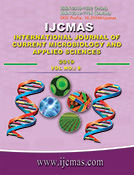


 National Academy of Agricultural Sciences (NAAS)
National Academy of Agricultural Sciences (NAAS)

|
PRINT ISSN : 2319-7692
Online ISSN : 2319-7706 Issues : 12 per year Publisher : Excellent Publishers Email : editorijcmas@gmail.com / submit@ijcmas.com Editor-in-chief: Dr.M.Prakash Index Copernicus ICV 2018: 95.39 NAAS RATING 2020: 5.38 |
Soil organic carbon (SOC) content is key component of the global carbon (C) cycle which is highly variable with respect to space and time. The main objective of this study was to provide an assessment of soil organic carbon (SOC) stock variability for Uttarakhand state. The other objective of this study was to evaluate the performance of different pedotransfer functions for reliable assessment of bulk density. Soil Resource Mapping for Uttarakhand state was conducted on 1:50,000 scale with the help of Satellite imagery (LISS III) along with exhaustive ground truthing through soil surveys. Stratiï¬Âed sampling was carried out based on remotely sensed satellite data for different slope, physiography and land-use/cover. The physico-chemical properties of selected samples for agriculture and forest land use were utilized for analyzing the performance of six pedotransfer functions for assessment of bulk density. The SOC stocks were estimated on the basis of soil organic matter content for top 20 cm layer and bulk density estimated from best performing pedotransfer functions models. The SOC stock class of 51-100 tonnes C ha-1 was dominated by covering 42.00% of state area followed by 26-50 tonnes C ha-1 class covering 23.74% area. Similarly, about 7.91% and 3.24 % area of state are covered under 11-25 tonnes C ha-1 and 101-160 tonnes C ha-1 classes, respectively. Remaining 22.44 % of state not forms part of study were mapped under settlement, snowbound area, drainages/rivers, reservoirs etc. The difference in performance of pedotransfer functions under different land use system implies the necessity of evaluation of pedotransfer functions before their implementation. Significantly greater SOC stocks were observed in forest and grassland/open-scrub land use and such differences can be attributed to the higher tree/shrub density, shrub/herb biomass and forest litter in the forest areas as compared to agriculture land use.
 |
 |
 |
 |
 |